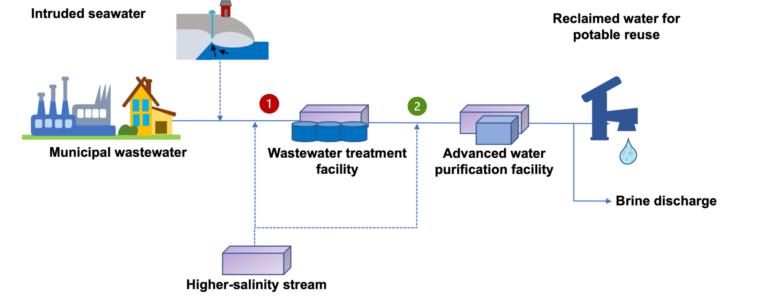In many places, including Southern California, climate change has increased the threat of drought and the need for new and continuous water resources. Higher salinity water streams, and sometimes seawater, come into consideration to alleviate such scarcity, but require higher energy investment due to the need to desalinate these streams. The proximity of some desalination facilities to wastewater reclamation facilities provides an opportunity to coordinate the two different water resources. Researchers at the USC Viterbi School of Engineering explored such opportunities in order to recover more water, at a reduced cost.
In research published in Desalination, Amy Childress, Gabilan Distinguished Professor in Science and Engineering, USC Viterbi doctoral student Xin Wei and Kelly Sanders, Dr. Teh Fu Yen Early Career Chair, studied current and future scenarios of wastewater treatment, particularly with regard to higher salinity streams. The goal: provide the most water supply possible, using as little energy as possible and with environmental stewardship in mind.
“While potable reuse and desalination have traditionally been considered separate parts of the water supply portfolio,” Childress, a professor in the Sonny Astani Department of Civil and Environmental Engineering, said, “it makes sense to consider ways we can blend wastewater treatment and desalination to meet water and energy goals while ensuring compliance with environmental standards.”
To understand this opportunity, one must consider the current context. First, the salinity of wastewater is increasing, in part due to water conservation. This higher salinity water stream is more expensive to treat, and may require a desalination process. Advancements at wastewater reclamation facilities mean that desalination processes (like reverse osmosis, which filters contaminated water through a semi-permeable material to clean it) can help treat higher salinity water streams relatively efficiently.
Harnessing existing water pressure
Said Childress: “Salinity is increasing in wastewater due to water conservation and other reasons. For example, in coastal areas, seawater can intrude into the infrastructure of wastewater reclamation facilities, also increasing salinity. The direct impact of increasing salinity is that you may need to operate existing desalination processes at higher pressures or you may need to introduce a new desalination process to treat the water.”
Traditionally, higher salinity streams have been a lower priority water resource due to how energy-intensive it is to desalinate such streams and clean the water to meet environmental and regulatory standards. However, if an existing desalination process can be retrofit or a new desalination process can be added, higher salinity streams that take advantage of the desalination capacity become more viable streams to meet water supply demands.
There are technologies that can be retrofitted into the facilities. These include: energy recovery devices (ERDs), which harness the energy in the brine output from desalination processes and apply it to the stream that is being newly treated; and closed-circuit reverse osmosis (CCRO), which maintains the pressure in the system instead of releasing it to the resulting brine. This helps to mitigate the additional salt burden without adding an additional energy burden, Childress said.
Energy management strategies for water reclamation
The discharge of brine is regulated by certain standards, Childress said, meaning saltiness of discharged streams must be below certain levels and likely similar to the salinity of ocean water, which is like 35 grams per liter. Initially, Ph.D. student Wei focused on the mixing of streams from different water sources with the perspective of meeting regulatory standards for salinity concentrations in the water stream. However, recently she has redirected her research to consider a different perspective.
Said Childress: “Wei considered instead, well, if we can meet the requirements by using the wastewater in a potable reuse fashion, instead of just blending the waste streams for discharge to the ocean, can we reuse it and take the water resource so we have that additional water supply?”
At advanced water purification facilities, use of reverse osmosis membranes—which apply pressure to push water through a semipermeable material while filtering out contaminants—to clean water has become industry standard, presenting an opportunity to treat higher salinity wastewater streams.
High energy costs in the water sector have led many water and wastewater treatment facilities to include energy management strategies. For example, energy recovery devices are commonly used in conjunction with high-salinity reverse osmosis processes to reduce energy consumption of the desalination process, the researchers said.
Energy recovery devices reduce energy consumption by transferring the pressure left in the (already treated) concentrated brine stream back to the feed stream. Energy recovery devices can reduce the energy consumption at seawater reverse osmosis desalination facilities by as much as 67%, depending on operating conditions, the researchers said.
High-recovery reverse osmosis processes (e.g., closed-circuit reverse osmosis) are being considered at advanced water purification facilities to improve water recovery while keeping energy consumption low. Membrane processes where the feed water is saltier require higher pressures (or energy). In a regular reverse osmosis process, the pressure is fixed at a high level that can overcome the final pressure in the concentrate. In closed-circuit reverse osmosis, the pressure is increased gradually to become just higher than the required pressure. Using time-variant feed pressure, closed-circuit reverse osmosis may provide greater energy savings than energy-recovery devices. Another benefit of closed-circuit reverse osmosis is that it can discharge less water.
Said Childress: “We’re trying to move toward flexibility in water treatment—assessing differences in water qualities and using different methodologies to treat that specific stream for the most efficiency and least waste.”
The future of water
Considerations of how to be flexible and sustainable in addressing water resources are becoming increasingly relevant as climate change-driven drought continues to threaten traditional water sources.
“Instead of creating a new technology or a new treatment process, we’re looking at synergies that could exist in coordination of adjacent facilities—something which is not currently being done,” Childress said.
Looking forward, Childress said looking at water differently might be key in utilizing it as efficiently as possible. Cities like Los Angeles have begun adopting an initiative called “One Water,” which aims to look at all the city’s water resources as one entity and work toward managing them in a more environmentally, economically and socially beneficial manner.
“Instead of categorizing water as stormwater versus wastewater versus seawater, what if we said it’s all water that needs to be treated?” Childress said. “Then we can take a look at our systems and evaluate what we need to accomplish this. The ultimate goal for a coastal city such as Los Angeles is to close the water loop—not sending water to the ocean but instead identifying every valuable resource in the discharge stream and finding ways to reuse it. Right now it’s too expensive to do this, but hopefully, this is where we’re heading.”
More information:
Xin Wei et al, Reclaiming wastewater with increasing salinity for potable water reuse: Water recovery and energy consumption during reverse osmosis desalination, Desalination (2021). DOI: 10.1016/j.desal.2021.115316
Provided by
University of Southern California
Citation:
Can we coordinate water sources to recover more water sustainably? (2021, November 19)



